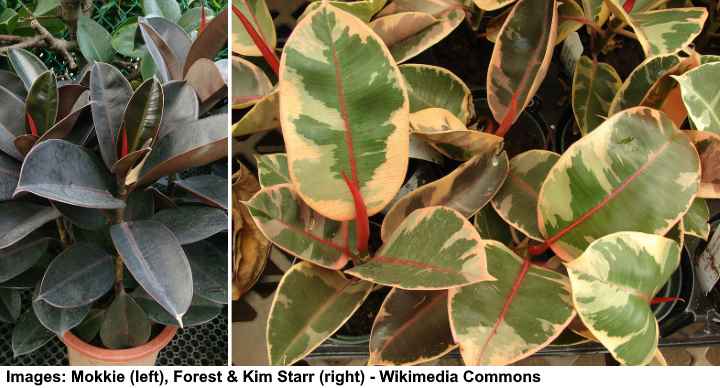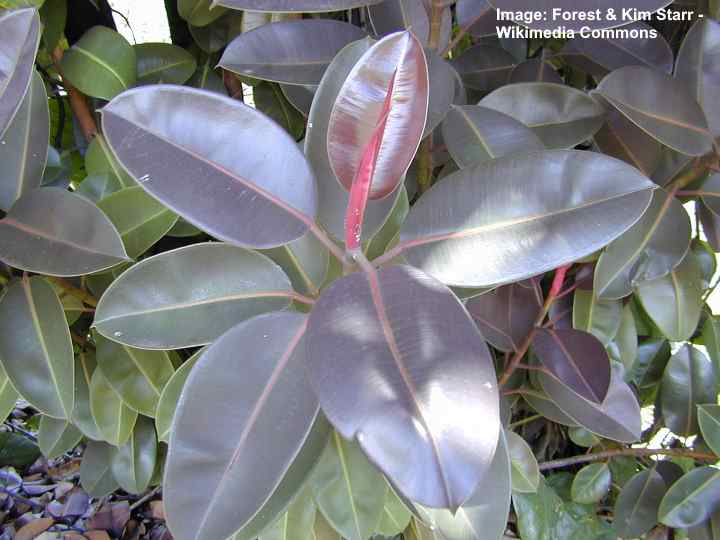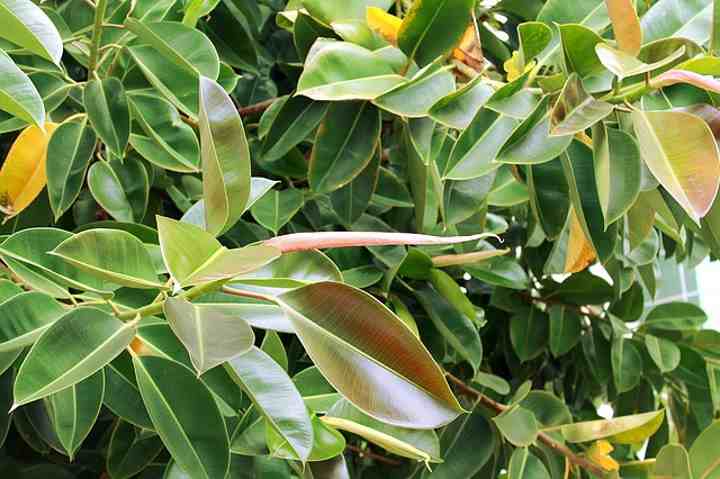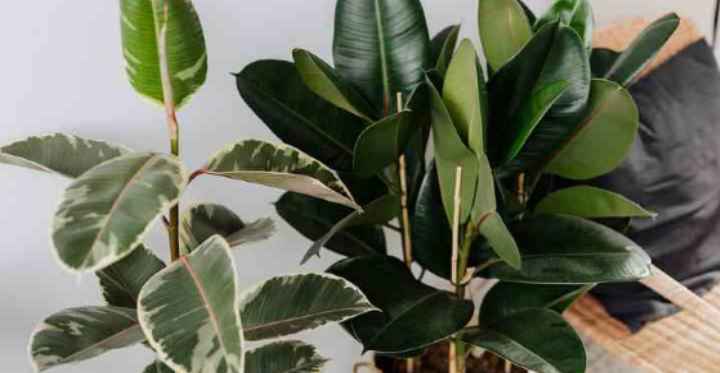The rubber tree plant, also known as Ficus elastica, is a simple to take care of houseplant. Indian rubber tree, rubber fig, and Indian rubber bush are some of the other names for this plant. Rubber plants are not only beautiful, but also provide functionality as they have thick, glossy, leathery green leaves and rapid growth.
The genus Ficus contains 800 species of trees and shrubs, including Ficus elastica. To add visual height, consider growing decorative rubber tree houseplants as a tiny desktop plant or a big rubber indoor tree. Variegated green and creamy white leaves are found on several of the appealing Ficus species.
How to care for Ficus elastica: The rubber tree plant thrives in bright, indirect sunlight, with somewhat damp soil and typical indoor humidity. water the rubber plant two to four weeks during the growing season if the top 2″ (5 cm) of potting soil is dry.
The rubber fig plant prefers temperatures of 60°F to 75°F (15°C to 24°C) indoors. The milky white sap of the species, which may be utilized to produce rubber, is known as rubber tree or rubber plant. If the rubber plant’s leaves and woody stems are cut or scraped, white sap oozes out.
While rubber trees are a blooming plant, they seldom (if ever) bloom indoors. The blossoms are insignificant if the rubber plant blooms. The leathery leaves of Ficus elastica are a attractive feature. Certain cultivars feature dark red or purple, virtually black leaves, such as the ‘Burgundy’ and ‘Black Prince.’
You’ll learn secrets and methods for keeping rubber tree plants healthy at home in this article. Several concerns regarding caring for these ornamental, leafy houseplants are answered at the conclusion of the care guide.
Varieties of Rubber Tree Plant (Ficus Elastica)

Several cultivars of rubber tree plants, such as variegated cultivars (right picture), are available. The rubber tree is one of the Feng Shui plants that are considered to bring good fortune. There are several types of rubber trees, including the normal Ficus elastica. Rubber trees come in a variety of shapes and sizes.
- Ficus elastica ‘Robusta’—Large oval leaves with a glossy and dark green appearance characterize the cultivar ‘Robusta.’
- Ficus elastica ‘Burgundy’—The leaves seem to be black in color and are deep burgundy. The plant’s stunning look is enhanced by the brilliant red new foliage.
- Ficus elastica ‘Tineke’—Green and white leaves with red veins on a popular variegated rubber plant.
- Ficus elastica ‘Ruby’—The crimson-pink and white leaves of this variegated Ficus cultivar have greenish undertones.
- Ficus elastica ‘Doescheri’—The variegated leaves of this rubber factory are elongated oval. Leaf colors may be green and pink, green and white, or combinations of green and lime-green depending on the cultivar.
How to Care for Ficus Elastica (Rubber Tree Plant)
Your baby rubber plant will quickly become a lovely houseplant if you take good care of it. Most types of Ficus elastica thrives in a variety of lighting scenarios. Variegated rubber plants, on the other hand, thrive in bright light. Only water the plant when the soil is partially dried. Let’s take a closer look at how to care for this plant at home.
How Much Light Does Rubber Fig Plant Need?

Ficus elastica plants thrive in low, indirect light and are protected from direct sunlight. An east-facing windowsill is an ideal location for a small rubber factory. Keep the plant pot away from the window or behind a sheer curtain if you must place it in a west- or south-facing room.
To grow quickly, all types of rubber plants (Ficus Elastica) require at least medium light. These aren’t plants that thrive in complete shade. If the indoor trees don’t get enough light, growth becomes leggy. If the plant’s container is in a darker spot, moving it to a brighter one may help with the appearance of sparse foliage on woody stems.
Planting variegated rubber plants in a well-lit area is the best strategy for growing them at home. To maintain the bright-yellow, white, or brilliant pink leaf patterns vivid and lovely, plenty of bright light is required. Low to medium light will support cultivars like Ficus elastica ‘Black Prince’ or ‘Burgundy,’ which have darker leaves.
The Best Potting Soil for Growing Rubber Tree Plants Indoors
Rubber plants need to grow in a well-aerated potting soil that has excellent drainage if they are to flourish indoors. To avoid any harm to the plant’s roots, water must drain quickly through the soil. Equal proportions of peat, pine bark, and perlite should be present in the greatest sort of growing medium.
The roots stay hydrated without becoming rotten thanks to the ingredients in potting soil. Peat, for example, retains moisture. Bark chips and perlite, for example, help to promote drainage. Indoor growing rubber trees in this potting soil mixture is perfect.
You may test whether your rubber plant potting soil is suitable in a variety of ways. Water, for example, shouldn’t form pools on the soil’s surface. The water in the plant pot should also drain quickly and easily through the drainage holes. You’ll have to repot your rubber plant if the water flows slowly. In two ways, repotting helps to support plant development:
- Remake compacted, nutrient-depleted soil.
- If the huge indoor tree has become rootbound, transfer to a bigger container.
How to Water Rubber Tree Plants

After the top layer of soil has dried out, water your rubber plant. Give your indoor Ficus soil a vigorous soaking. The roots are hydrated while they are soaking in the soil. However, overwatering must be avoided. As a result, until the top 1″ to 2″ (2.5 – 5 cm) of soil is dry, water the plant only.
How much should you water a rubber plant? The quick solution is to water rubber trees as soon as the soil begins to dry out. Poke your finger about 2 inches (5 cm) into the soil to determine when it’s time to water your plant. It’s time to give your plant a big watering if the medium is dry.
Rubber plants that are immersed in water for too long are usually harmed. Allowing all of the water to drain from the soil can save a dying rubber plant. Also, check to see that the saucer isn’t full of water. The frequency with which you should water your plant is influenced by a variety of factors:
- Season and climate—Because growth becomes dormant during the winter, water Ficus plants are less common. Always rely on soil to tell you when it’s time to water.
- Type of pot—Since clay pots lose moisture quicker than plastic ones, you’ll need to water the plant more often.
- Rootbound—The roots take up almost all of the pot when a plant is rootbound. You have to water rubber plants less often as a result of this, making the growing medium denser. Rootbound plants are more likely to experience damp soil and root rot.
Top care tip when watering rubber plants: Before watering, allow the water to sit for a few hours. This permits poisonous chemicals in tap water to escape and raise the temperature of the water to a comfortable level for watering any kind of plant.
Room Temperature Requirements for Ficus Elastica
If the temperature is consistent, indoor room temperatures are optimum for rubber tree growth. Between 60°F and 75°F (15°C – 24°C) is the ideal temperature range for keeping plants healthy. However, in temperatures of 55°F (12°C), the rubber plants will still thrive, albeit at a slower pace.
Rubber trees don’t like cold drafts, even if they are quite hardy indoors. Plants should be kept away from drafty windows and doors, as well as air conditioning flows, in the summer. It’s also critical to maintain a consistent temperature. In the winter, don’t put rubber plants near heated radiators.
Outdoors in USDA zones 10 to 12, Ficus elastica rubber tree plants thrive. Your rubber plants should be planted in a bright location with dappled sunlight. If you reside in temperate regions, you can still cultivate rubber plants in pots outside throughout the summer. The plant’s roots may suffer from dampness and cold when the temperature drops below 50°F (10°C).
Rubber Tree Humidity Requirements

The humidity requirements for rubber tree plants are medium. Rubber plants thrive vibrant and healthy in a room with an average humidity of 70%. When growing indoors, you may need to humidify the plant on occasion. During hot, dry summers, for example, you’ll have to spray its leaves. In addition, winter misting is a good idea because household heating tends to dry the air.
You can wipe the leaves with a wet cloth if you prefer to mist them occasionally. Cleansing the leaves in this manner not just adds water to the plant but also removes dust from the glossy, huge, broad leaves. Place the rubber plant on a humidifying pebble tray if your home air is particularly dry. To humidify Ficus elastica plants, follow these steps:
- In a large tray, lay a layer of little pebbles or ornamental stones.
- Bring the water to halfway up the stones in the tray.
- Make sure the water does not come into direct contact with the soil when you place the rubber tree plant pot on the pebbles.
- Your rubber plant thrives in a humid environment as water evaporates.
Rubber Plant Flowers
Ficus elastica, a native of Southeast Asia, is a flowering plant. Rubber plants, on the other hand, are attractive foliage rather than blossoms. These fig plants have tiny, green flowers that aren’t aromatic, stunning, or bright. If a rubber plant blooms indoors, it’s even more unusual.
The fresh leaf development on the plant has been confused with floral growth by many people. On most rubber plant cultivars, new growth appears as a bright red sheath that subsequently yields to fresh leathery leaves.
Rubber Tree Plant Growth Rate

In bright light and warm temperatures, rubber plants grow faster. All varieties of Ficus elastica plants have a moderate growth rate, as seen in this picture. A baby rubber tree with broad oval leaves will swiftly turn into a bigger Rubber Tree in the spring. Bright light, frequent feeding, and warm temperatures are the ideal conditions for fast rubber tree development.
The plant’s development rate slows during late fall and winter. Further, if the rubber plants become rootbound, their growth nearly comes to a halt. Winter feeding should be limited, and rootbound plants should be repot in the spring. Rubber plants can quickly develop into huge indoor trees, providing a lovely aesthetic boost to any area or workplace if they are not pruned. Rubber plants may reach heights of up to 10 feet (3 m) in an indoor setting with pots being grown.
Feeding Indoor Rubber Tree
Feed the rubber tree plant twice to four weeks throughout the growing season, which runs from March till September. Dilute the fertilizer concentration to half strength for use with houseplants. During the winter, don’t feed the plant since this may lead to it dying from overfeeding.
Pruning a Rubber Tree
The height of a Ficus elastica can be controlled by pruning it. Trim the top of the plant to the height that you want to prune it. The plant’s look is improved by removing the stems with dead or dying leaves. Cut the stems of the plants just above the node to encourage more compact development.
Ficus Elastica Propagation

Stem cutting is used to propagate a rubber plant. Cutting the main stem down to one leaf, leaving one leaf on it. Wait until the milky sap stops flowing from the stem before cleaning it off. Cut the stem about 6 inches (15 cm) long and leave one leaf on it to start a new plant. Place the stem in a warm, bright location after cutting it in moist perlite. Between 70°F and 75°F (21°C – 24°C) is ideal for the plant to take root.
Repotting an Indian Rubber Tree Plant
Eventually, to maintain the rubber plant’s development, you’ll have to move it to a bigger container. Refreshing the potting soil and checking for rotting roots are both options when repotting a Ficus plant in the spring. All you have to do is move the plant from one potting medium to another.
Untangle the roots of the rubber plant when you remove it from its current container. Trim with sterile scissors if necessary, and look for brown, mushy roots. Water the plant thoroughly and put it in bright, indirect light after planting it in its new container.
Is Ficus Elastica (Rubber Plant) Toxic?
Animals and household pets like cats and dogs should avoid rubber trees. Indian rubber plants contain harmful enzymes ficin and ficusin, according to the American Society for the Prevention of Cruelty to Animals (ASCPA). Therefore, keep dogs and cats away from the plant.
Pests and Disease Affecting Rubber Tree Growth
Ficus elastica is a toughy houseplant that is insect resistant and tolerant. Scale, spider mites, and mealybugs are the most common forms of plant pests you might encounter on your fig tree. These indoor plant pests may usually be eliminated using a neem oil solution.
To understand what to do about scale insects, mealybugs, or spider mites, please read this article on how to eliminate houseplant pests naturally. Certain types of rubber plants may be mistaken for pests because they have raised white dots. The white bumps, on the other hand, are natural and innocuous.
FAQs About Caring for Rubber Tree Plant Indoors

Ficus elastica ‘Shivereana’ is a photograph of the plant.
Why are rubber plant leaves curling?
Curling leaves are often a indication that a rubber tree plant has been overwatered. If you leave the soil to dry out, the leaf development usually solves itself. Ficus plant leaves may also curl in response to growing in hot temperatures above 85°F (29°C). Exposure to frost might explain why the leaves curl and then fall.
How to make a rubber plant bushy?
To promote bushy development, leggy rubber plants need trimming. If there isn’t enough sunlight, the plant may become leggy. Get a bushy rubber plant with compact growth by cutting back the stems just above the node. Also, to avoid leggy growth in the future, keep the plant in a brighter location.
Why are my rubber plant leaves falling off?
The most prevalent cause of leaf drop is overwatering rubber trees. If the potting mixture is too wet or if the plant has been sitting in water for too long, leaves start to fall. To help the plant avoid dying, you may have to repot it with fresh soil in severe situations. Only water the plant when the soil is mostly dry after that.
Why are ficus leaves turning yellow?
Rubber plant leaves can become pale and yellow for a number of different reasons. First and foremost, old leaves naturally fall away. It might be caused by too much water, soggy soil, or insufficient light if many leaves are yellowing. Your plant will be revived by addressing the reasons.
